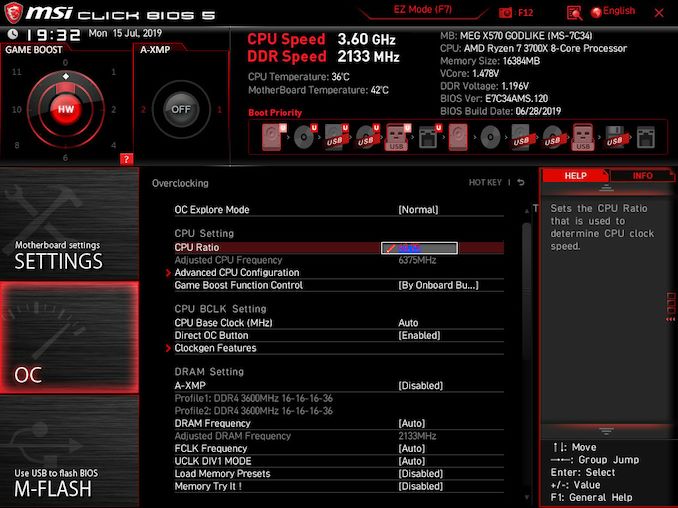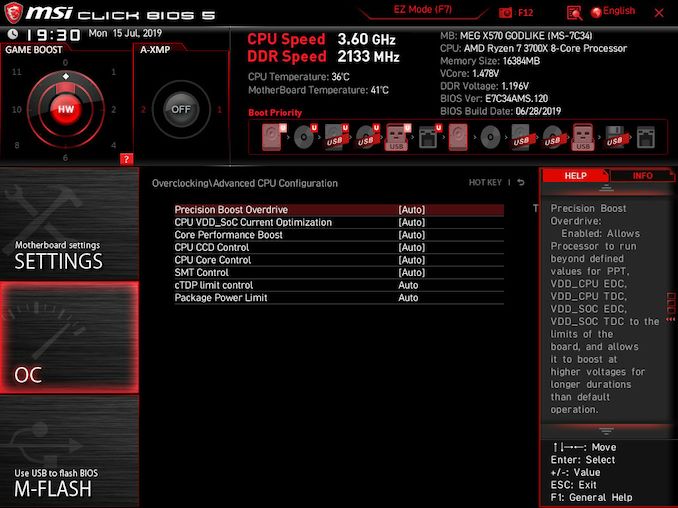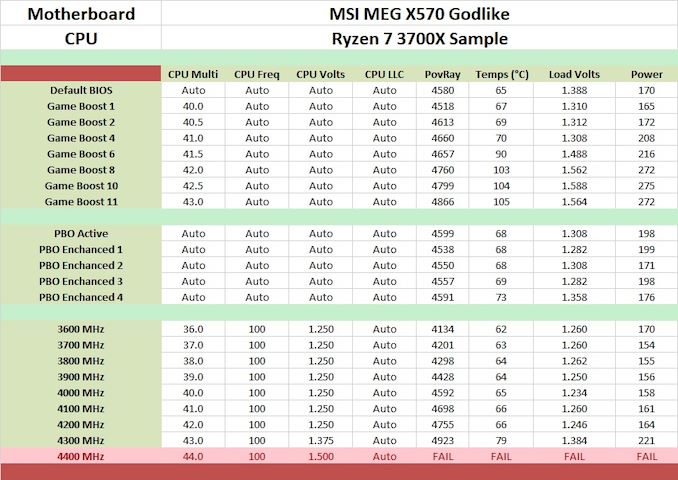The MSI MEG X570 Godlike Motherboard Review: Thor's Flagship
by Gavin Bonshor on August 28, 2019 12:00 PM EST- Posted in
- Motherboards
- AMD
- MSI
- 10G Ethernet
- Ryzen
- PCIe 4.0
- Ryzen 3000
- X570
- X570 Godlike
- MEG
Overclocking Ryzen 3000
Experience with the MSI MEG X570 Godlike
Overclocking with the Ryzen 3000 series hasn't exactly titillated users since its launch with there not being much headroom available. The biggest issue with this boils down to all-core overclocks being limited by the worst core of the chip. and the new 7 nm processors running quite warm. To get the best experience and results with the Ryzen 3000, users with good quality AIOs and custom water cooling yields the best outcome, and even with voltages of 1.375 V, these chips can run a little too warm for comfort.
The MSI Click BIOS 5 firmware is familiar to us and throughout the different chipsets including X399, X470, and Z390, the MSI MEG X570 Godlike uses the same design layout and setup. Within the OC section of the firmware, users can alter important settings such as the CPU ratio which can be changed in steps of 0.25 MHz, with relevant settings including CPU VCore, CPU Base Clock, and even FCLK frequency. Deeper into the firmware is settings to set the load line calibration (LLC) to a more aggressive or liberal profile, as well as all the Precision Boost Overdrive (PBO) settings.
The three main settings that PBO works from include package power tracking (PPT), thermal design current (TDC), and the electrical design current (EDC). All three of these can be set within the firmware under the advanced section of the Precision Boost Overdrive menu, although MSI has included four different PBO profiles for users to select from. The higher the setting, the higher the thermal and power draw will be, and it may not necessarily matter if a sub-par cooler is installed; it's noted that Ryzen 3000 processors work better when they are cooler.
There are seven different MSI Game Boost profiles to select from and users can access them via the dial at the bottom of the board, or through the firmware itself. The Game Boost profiles within the firmware can be accessed through the dial in the top left-hand corner. These profiles range from 4.0 GHz through to 4.3 GHz, and we've tested each of them below.
Overclocking Methodology
Our standard overclocking methodology is as follows. We select the automatic overclock options and test for stability with POV-Ray and OCCT to simulate high-end workloads. These stability tests aim to catch any immediate causes for memory or CPU errors.
For manual overclocks, based on the information gathered from the previous testing, starts off at a nominal voltage and CPU multiplier, and the multiplier is increased until the stability tests are failed. The CPU voltage is increased gradually until the stability tests are passed, and the process repeated until the motherboard reduces the multiplier automatically (due to safety protocol) or the CPU temperature reaches a stupidly high level (105ºC+). Our testbed is not in a case, which should push overclocks higher with fresher (cooler) air.
Overclocking Results
As it currently stands, MSI's Game Boost overclocking profiles need quite a bit of refinement, something they have informed us that these will be rectified with a new firmware revision; we will test this when we receive the board back from MSI. The issue with these is CPU VCore, or in a nutshell, too much of it which cross the board into the unsafe territory of the Ryzen 3000 processors safety limits; both in CPU VCore and in temperature. When we activated PBO and MSI's preset profiles for this, it didn't make much of an impact over the stock settings, which seems to be a reoccurring issue so far across the range of models we have tested so far.
Manually overclocking the MSI MEG X570 Godlike proved very fruitful and we managed to hit what seems to be the limits of our Ryzen 7 3700X testbed CPU with an overclock of 4.3 GHz all-cores with a CPU VCore of 1.35 V, which seems to be the brick wall for our processor. Even with a CPU VCore of 1.50 V, we couldn't get 4.4 GHz to remain stable when any kind of semi-intensive load was placed on the processor, although we did manage to boot into Windows 10 without fanfare with these settings. The performance wasn't throttled in POV-Ray throughout each of the frequencies tested and once the temperature limit of 110ºC is exceeded, the system will safely shut down. From 3.6 to 4.2 GHz, we managed to do this with a set CPU VCore of 1.250 V which did fluctuate slightly under load under the auto LLC setting. It is safe to say that the MSI MEG X570 Godlike doesn't have a VDroop issue and even at 4.3 GHz, a set CPU VCore of 1.375 resulted in a maximum load voltage of 1.384 V which isn't too far off the mark.













116 Comments
View All Comments
oynaz - Saturday, August 31, 2019 - link
I actually prefer more cores to faster cores in my DAW. Each effect bus, or track, cannot be split into multiple cores, true, but you usually quite a few buses going.inighthawki - Friday, August 30, 2019 - link
GamingSweetbabyjays - Thursday, August 29, 2019 - link
In a professional setting, where you are doing thread intensive workloads, and IT is not cool with you overclocking...then yes, I totally agree 3900x makes way more sense."use less power overall" ? 9900k has a TDP of 95W, while the 3900x has a TDP of 105W, Additionally the Z390 chipset has a TDP of 6W while the X570 has a TDP of 11W. Now I know there is a discrepancy between how AMD and Intel measure TDP, so the numbers at face value may not be telling the whole story. That said, I would be very interested to see overall system power draw for both to test the veracity of your statement.
AshlayW - Thursday, August 29, 2019 - link
Oh boy, you actually think the 9900K uses 95W? Joke's on you pal, that's at 3.6 GHz. At full turbo clocks the 9900K uses 150-200W. Ryzen 3000 is almost twice the performance per watt in some scenarios.Trikkiedikkie - Saturday, August 31, 2019 - link
With the 3900 having many things inside the processor, whereas the 9900 has extra chips needed. And Intel's numbers only count for baseclockSweetbabyjays - Thursday, August 29, 2019 - link
"trounce it with it's higher core-count parts in multi-threaded scenarios." Aside from some synthetic benchmarks, I suggest looking at the puget systems website for professional benchmarks, if you're looking for more real world professional performance scenarios.The 12 core part is better in some(in some the 9900k is better) scenarios, but rarely(if ever) by more than 10%. Perhaps your definition of "trounce" is different from mine thought.
If you're gaming much more often than you are working/creating the increased core count really wont improve your overall computing experience, if at all.
Oliseo - Thursday, August 29, 2019 - link
This is true. But the argument remains, just how many people actually use highly mutli-threaded scenarios.I'd wager if you got a venn diagram of gamers and content creators, the content creators would simply be a small spot on the very large gaming circle.
I know a lot of gamers, yet I struggle to meet 3D cad designers or Film Editors.
So yes, you're right, AMD will trounce Intel in that respect. But until we get games using more than 8 cores, the majority of people will not be better off because they simply don't need those extra cores as they don't run any software that can make use of them.
And that goes for AMD folks wanting to get the AMD chips as well.
Trikkiedikkie - Saturday, August 31, 2019 - link
Gaming is soo small compared to people doing actual work.AshlayW - Thursday, August 29, 2019 - link
$150 more, for 10% higher single core performance when both CPUs already have extremely good single core performance, and you can place a 4700X in the same motherboard next year that will have even higher single core than the 9900K? Seriously people, consumer stupidity is why Intel is still selling CPUs.Trikkiedikkie - Saturday, August 31, 2019 - link
Single core is soooo last century.Only people that have very little serious work apart from Adobe want that.